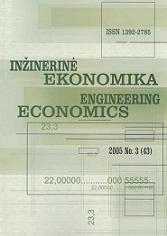Human Resource Training Evaluation
Human Resource Training Evaluation
Author(s): Vilmantė KumpikaitėSubject(s): Economy
Published by: Kauno Technologijos Universitetas
Keywords: Human resource training; human resource training evaluation; human resource training costs; returns on investment
Summary/Abstract: This paper draws on prior research on human resource training evaluation, including its models, criteria, tangible and intangible benefits of training and return on investment. Human resource management (HRM) is the recognition of the importance of an organization’s workforce as vital human resources contributing to the goals of the organization, and the utilization of several functions and activities to ensure that they are used effectively and fairly for the benefit of the individual, the organization, and society. Today human resource management has a unique and timely opportunity to improve productivity. Increasingly, however, improving productivity does not mean just increasing output. In addition, evaluation ensures that programs are accountable and are meeting the particular needs of employees in a cost-effective manner. This is especially important today, as organizations attempt to cut costs and improve quality in their firms. Without evaluation, it is very difficult to show that training was the reason for any improvements. Human resource training may safeguard productivity as well as supporting it, insulating firms from skills shortages by preparing employees for current and future jobs. Evaluation involves identifying the appropriate outcomes to measure. The outcomes used in evaluating training programs include trainees’ satisfaction with the training program, learning of knowledge or skills, use of knowledge and skills on the job, and results such as sales, productivity, or accident prevention. Evaluation may also involve comparing the costs of training to the benefits received (return on investment). Outcomes used in training evaluation help to determine the degree to which the program resulted in both learning and transfer of training. Training evaluation provides a way to understand the investments that training produces and provides information needed to improve training. If the company receives an inadequate return on ist investment in training, the company will likely reduce its investment in training or look for training providers outside the company who can provide training experiences that improve performance, productivity, customer satisfaction, or whatever other outcomes the company is interested in achieving. Training evaluation provides the data needed to demonstrate that training does provide benefits to the company. This paper is organized as follows. First the purpose of human resource training evaluation is shown. Next, analysis of human resource training evaluation models is provided. Third, human resource training’s evaluation process is shown. Fourth and fifth, evaluating of human resource training costs and returns of investments are discussed. Sixth hard and soft data in training evaluation is described. Later, costs of training in Lithuanian companies are demonstrated. Finally, conclusions of this paper are given.
Journal: Engineering Economics
- Issue Year: 2007
- Issue No: 5 (55)
- Page Range: 29-36
- Page Count: 8

